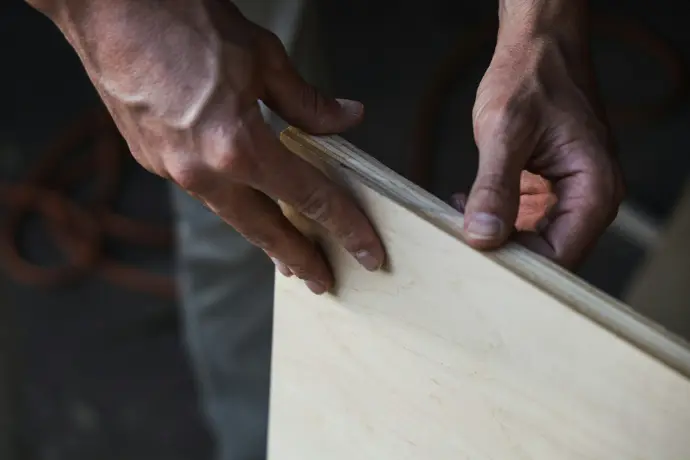Career
Target groups for the CPC30220 Certificate III in Carpentry are students who are:
• Seeking to pursue a career in Carpentry
• Seeking to enter a new industry sector
• Seeking a pathway to higher-level qualifications.
The qualification is suited for international students who wish to apply to develop tradesperson-level skills in constructing, installing, and repairing timber and other material-based structures, including cabinetry and furniture.
Minimum age to enrol in this qualification is 18 years.
Credit and/or RPL can be provided for those with existing skills and knowledge allowing such students to complete the course in a shorter timeframe.
Course Structure
Units of Study
To achieve this qualification, the student must demonstrate competency in 34 units of competency; 27 CORE and 7 ELECTIVE
|
Code |
Title |
Core/Elective |
|
CPCCCA2002 |
Use carpentry tools and equipment |
Core |
|
CPCCCA2011 |
Handle carpentry materials |
Core |
|
CPCCCA3001 |
Carry out general demolition of minor building structures |
Core |
|
CPCCCA3002 |
Carry out setting out |
Core |
|
CPCCCA3003 |
Install flooring systems |
Core |
|
CPCCCA3004 |
Construct and erect wall frames |
Core |
|
CPCCCA3005 |
Construct ceiling frames |
Core |
|
CPCCCA3006 |
Erect roof trusses |
Core |
|
CPCCCA3007 |
Construct pitched roofs |
Core |
|
CPCCCA3008 |
Construct eaves |
Core |
|
CPCCCA3010 |
Install windows and doors |
Core |
|
CPCCCA3016 |
Construct, assemble and install timber external stairs |
Core |
|
CPCCCA3017 |
Install exterior cladding |
Core |
|
CPCCCA3024 |
Install lining, paneling and molding |
Core |
|
CPCCCA3025 |
Read and interpret plans, specifications and drawings for carpentry work |
Core |
|
CPCCCA3028 |
Erect and dismantle formwork for footings and slabs on ground |
Core |
|
CPCCCM2006 |
Apply basic levelling procedures |
Core |
|
CPCCCM2008 |
Erect and dismantle restricted height scaffolding |
Core |
|
CPCCCM2012 |
Work safely at heights |
Core |
|
CPCCCO2013 |
Carry out concreting to simple forms |
Core |
|
CPCCOM1012 |
Work effectively and sustainably in the construction industry |
Core |
|
CPCCOM1014 |
Conduct workplace communication |
Core |
|
CPCCOM1015 |
Carry out measurements and calculations |
Core |
|
CPCCOM3001 |
Perform construction calculations to determine carpentry material requirements |
Core |
|
CPCCOM3006 |
Carry out levelling operations |
Core |
|
CPCCWHS2001 |
Apply WHS requirements, policies and procedures in the construction industry |
Core |
|
CPCWHS3001 |
Identify construction work hazards and select risk control strategies |
Core |
|
CPCCSF2004 |
Place and fix reinforcement materials |
Group A - Specialist Elective |
|
CPCCCA3012 |
Frame and fit wet area fixtures |
Group A - Specialist Elective |
|
CPCCCM2002 |
Carry out hand excavation |
Group A - Specialist Elective |
|
CPCCCA3027 |
Set up, operate and maintain indirect action powder-actuated power tools |
Group A - Specialist Elective |
|
CPCCOM1013 |
Plan and organize work |
Group B - General Elective |
|
CPCCCA3011 |
Refurbish timber sashes to window frames |
Group B - General Elective |
|
CPCWHS1001 |
Prepare to work safely in the construction industry |
Imported Elective |
Entry Requirements
Age Requirements
Students must be over 18 years of age at the time of course commencement.
Academic Requirements
To gain entry to this course, students must have successfully completed Year 12 or secondary studies in applicant’s home country equivalent to an Australian Year 11* or 12 qualifications
English Proficiency
A minimum IELTS band score of 6.0 (Academic or General) or an equivalent score, following Department of Education and Department of Home Affairs (DHA) regulations, is necessary (Refer to the Application, Enrolment, and Orientation policy for more details). Online IELTS is not accepted; refer to https://immi.homeaffairs.gov.au/help-support/meeting-ourrequirements/english-language for additional information.
- Competency in written and spoken English is mandatory, and students will undergo a Language, Literacy, and Numeracy test before starting the training (Refer to LLN policy for further details).
Additional Requirements
- Internet access with a computer featuring up-to-date software, including Microsoft Office, Adobe Acrobat Reader, and Adobe Flash Player, is essential.
- Basic digital literacy, involving the ability to communicate and access information through digital technologies like internet platforms, social media, search engines, emails, and basic use of MS Office products, is expected.
- Students must possess the physical capability to handle the demands of training and assessment, including working at heights, heavy lifting, manual labor, and operation of tools (both manual and power tools).
- Internet access with a computer featuring up-to-date software, including Microsoft Office, Adobe Acrobat Reader, and Adobe Flash Player, is essential.
Assessment methods: Assessment is undertaken in a variety of ways, happening in the classroom under supervision of a qualified trainer and assessor or can be undertaken outside the classroom (as a home study) due to the need of research or in-depth analysis. In this qualification, assessment methods used include written test, skill test, presentation, case study, report etc.
Delivery mode: This course is offered full-time over 52 weeks including holidays on a full-time basis This includes 40 weeks of term time and 12 holiday weeks. During term, time students attend scheduled face-to-face classes for 20 hours per week that includes assessment hours as well. Students will be required to undertake additional independent study for 5 hours per week.
Weekend classes: CSK offers weekend classes providing added flexibility to accommodate your schedule
Course Credit/ RPL
All students are provided with the opportunity to have their prior learning and experience assessed against current standards and gain recognition for this. (Recognition of Prior Learning - RPL) Students who have successfully completed whole units of competency included in this course can apply for Credit. The Credit and RPL application processes are provided to students in pre-enrolment information in accordance with the RPL process and Provide Credit for Prior Studies process.
Student support
Student needs are declared by the applicant at the time of enrolment. The application form allows the applicant to self-declare where they have learning disabilities. Furthermore, in order to provide students with the most tailored support possible, every student is interviewed face-to-face or over the telephone in attempt to establish the applicant skill and knowledge levels, their current employment and how that relates to the course content and interaction


